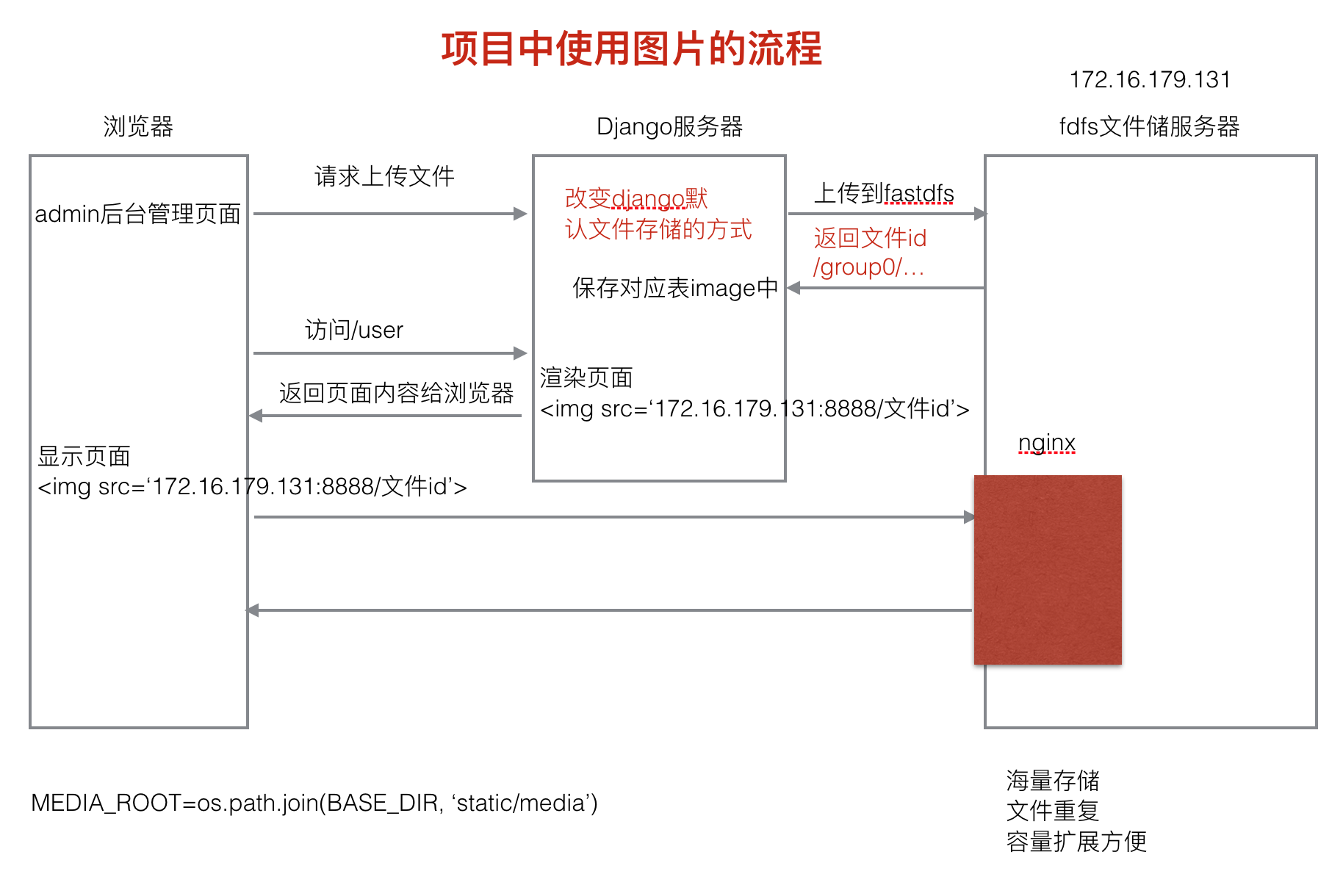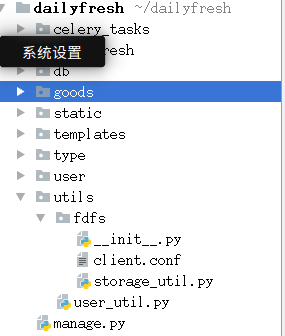1. The process of uploading and displaying pictures after Django integrates FastDFS
2.FastDFS Installation (Operation in Virtual Machine Environment), (omitted)
3.Django Project Core Code
(1) File location:
(2)storage_util.py
from django.core.files.storage import Storage
from django.conf import settings
from fdfs_client.client import Fdfs_client
class FDFSStorage(Storage):
'''fast dfs File Storage Class'''
def __init__(self):
'''Initialization'''
self.client_conf=settings.FDFS_CLIENT_CONF
self.base_url=settings.FDFS_URL
def _open(self,name, mode='rb'):
'''Use when opening a file'''
pass
def _save(self,name, content):
'''Use when saving files'''
#Name: You choose the name of the uploaded file
#Content: File object that contains the content of your uploaded file
#Create a Fdfs_client object
client=Fdfs_client(self.client_conf)
#Upload files to fast dfs system
res=client.upload_by_buffer(content.read())
print('res',res)
#
# {
# 'Uploaded size': '9.69KB',
# 'Storage IP': b'192.168.12.189',
# 'Group name': b'group1',
# 'Status': 'Upload successed.',
# 'Local file name': '',
# 'Remote file_id': b'group1/M00/00/00/wKgMvVvHKzeAFiJkAAAmv27pX4k7691647'
# }
if res.get('Status')!='Upload successed.':
#Upload failure
raise Exception('Upload files to FastDFS fail')
#Get the returned file ID
filename=res.get('Remote file_id').decode()
return filename
def exists(self, name):
'''Django Determine whether the file name is available'''
return False
def url(self, name):
'''Return the access file url Route'''
return self.base_url+name
(3) Configuration added to settings.py
#FastDFS Settings - Classes for Custom Storage DEFAULT_FILE_STORAGE='utils.fdfs.storage_util.FDFSStorage' #FastDFS Settings - Client Configuration File FDFS_CLIENT_CONF='utils/fdfs/client.conf' #FastDFS Settings - url FDFS_URL='http://192.168.12.189:9999/'
(4)client.conf
Client.conf needs to add a modified configuration, which can be opened by the sudo vim/etc/fdfs/client.conf command (following is my configuration, which may vary depending on the environment).
# connect timeout in seconds # default value is 30s connect_timeout=30 # network timeout in seconds # default value is 31s network_timeout=60 # the base path to store log files base_path=/home/cuixin/fastdfs/tracker # tracker_server can ocur more than once, and tracker_server format is # "host:port", host can be hostname or ip address tracker_server=192.168.12.189:22122 #standard log level as syslog, case insensitive, value list: ### emerg for emergency ### alert ### crit for critical ### error ### warn for warning ### notice ### info ### debug log_level=info # if use connection pool # default value is false # since V4.05 use_connection_pool = false # connections whose the idle time exceeds this time will be closed # unit: second # default value is 3600 # since V4.05 connection_pool_max_idle_time = 3600 # if load FastDFS parameters from tracker server # since V4.05 # default value is false load_fdfs_parameters_from_tracker=false # if use storage ID instead of IP address # same as tracker.conf # valid only when load_fdfs_parameters_from_tracker is false # default value is false # since V4.05 use_storage_id = false # specify storage ids filename, can use relative or absolute path # same as tracker.conf # valid only when load_fdfs_parameters_from_tracker is false # since V4.05 storage_ids_filename = storage_ids.conf #HTTP settings http.tracker_server_port=80 #use "#include" directive to include HTTP other settiongs ##include http.conf
(5)urls.py
from django.conf.urls import url
from . import views
urlpatterns = [
#url(r'^$',views.index,name='index'),
url(r'^$',views.IndexView.as_view(),name='index'),
]
(6)views.py
from django.shortcuts import render
from django.views.generic import View
from goods.models import *
# def index(request):
# return render(request,'index.html')
class IndexView(View):
def get(self,request):
# Get information about the types of goods
goodstype_list = GoodsType.objects.all()
# Preparing a Data Dictionary
context = {'goodstype_list':goodstype_list}
#Back to home page
return render(request,'test_index.html',context)
(7)test_index.html
<!DOCTYPE html>
<html lang="en">
<head>
<meta charset="UTF-8">
<title>Title</title>
</head>
<body>
<ul>
{% for goodstype in goodstype_list %}
<li>
<ul>
<li>{{ goodstype.name }}</li>
<li><img src="{{ goodstype.image.url }}"></li>
</ul>
</li>
{% endfor %}
</ul>
</body>
</html>
4. advantages
FastDFS Solution:
(1) Massive storage of files
(2) Document duplication
Integration with Nnix:
(1) Improving the efficiency of static file access